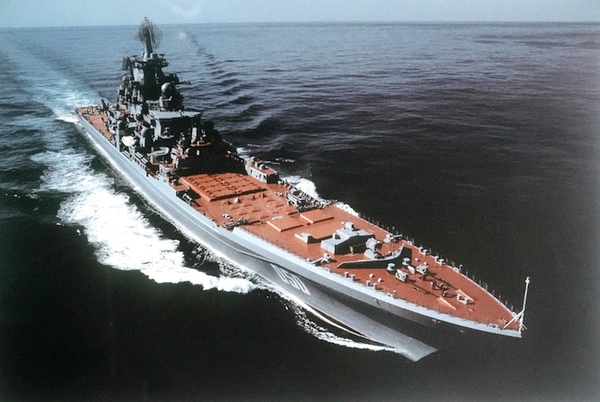HEXAGON vs. Kirov: American satellite reconnaissance and the Soviet Union’s most powerful warshipby Dwayne A. Day
|
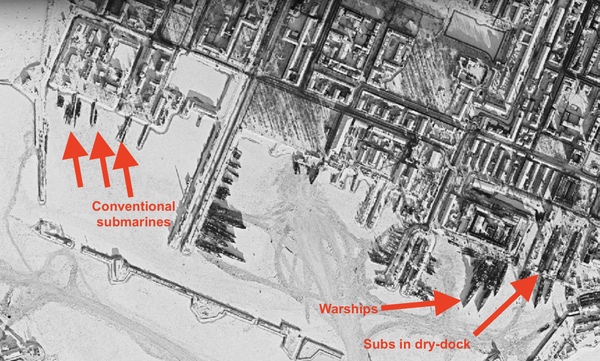 Leningrad (now St. Petersburg) was the Soviet Union's major naval base on the Baltic. The base supported conventional submarines and surface warships. In this February 1972 HEXAGON satellite photo, numerous Soviet submarines and ships are in port. The ice has been partially cleared to permit the vessels to move. Nearby, Leningrad was the location of a major shipyard. |
Big Bird
In February 1972, the second HEXAGON reconnaissance satellite launched, known as mission 1202, photographed Leningrad—now St. Petersburg—on a rare cloud-free winter’s day. Leningrad was the Soviet Union’s major naval port on the Baltic Sea. The large shipyard facilities as well as the naval base were clearly visible, as were the narrow channels carved through the ice to permit vessels to transit. Numerous warships were in port, with submarines moored, as well as in drydock.
The HEXAGON had only entered service in summer 1971, and it was an important new intelligence asset for the United States. It was the size of a school bus and had earned the nickname “Big Bird” from those who knew little of its characteristics other than its size. Its two powerful cameras could photograph a massive amount of territory in each sweep over the Earth, and each image could be enlarged many times to reveal details down to approximately half a meter or less on the ground. A single camera sweep could cover the distance between Washington, DC, and Columbus, Ohio, with sufficient detail to spot every vehicle on every street in both cities and identify if they were car or truck. A single HEXAGON mission would photograph the entire Soviet landmass in a few weeks, with the goal of revealing any significant changes since the last mission, such as new missile silos, the deployment of bombers, or the construction of new ships. It took time for the satellite to fill each of its four reentry vehicles before sending it to the ground, and the photographs were often a week or more old before they were looked at by photo-interpreters. But they contained so much data that it was a challenge to analyze everything they photographed behind the Iron Curtain.
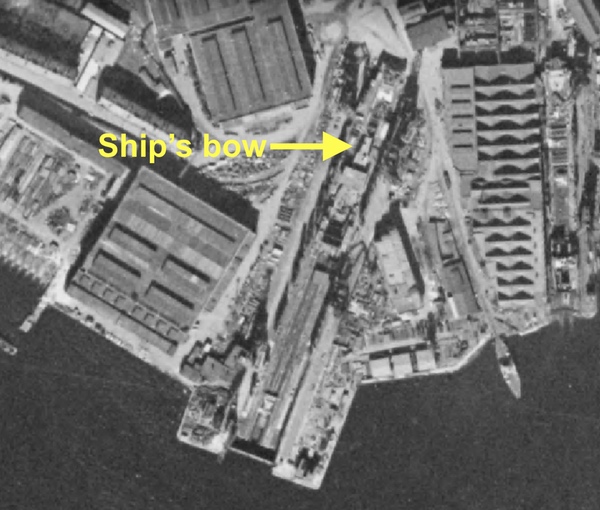 In early 1974, American satellites spotted a large surface combatant under construction at the major shipyard in Leningrad. The shape of the hull and machinery spaces indicated that it was a warship and not a cargo ship or ice breaker. Although only the bow and forward section had been constructed, it was clear that this would be a massive vessel. |
In April 1974, HEXAGON mission 1208 photographed Leningrad and revealed that one of the oldest shipyards in the Soviet Union, which had built battleships and submarines, was now working on a large new combatant. The ship’s bow was clearly visible, along with other equipment along the shipway, some of which was required for sliding the ship into the water upon partial completion. By July 1975, HEXAGON mission 1210 photographed the shipyard, revealing even further progress on the large combatant, with more of the hull taking shape.
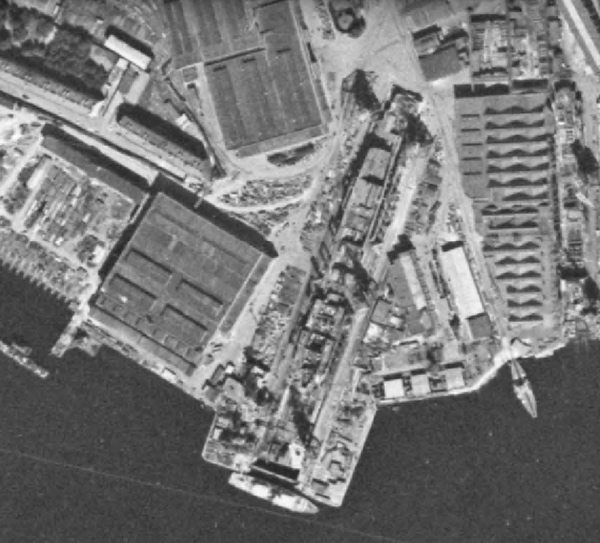 As American satellites kept watch, the construction of the new combatant took shape. Here the bow is partially obscured by cranes. American intelligence analysts concluded that the ship would be nuclear-powered, possibly by observing the reactor components arriving at the shipyard. |
In February 1978, the US Navy’s highest-ranking officer, Chief of Naval Operations Admiral James L. Holloway, confirmed in front of Congress—in a rather oblique way—that the ship had recently been launched.[1] At the time, American satellite reconnaissance was highly classified, and Holloway was not about to reveal his sources. Satellite reconnaissance was also highly reliable, unlike human sources. In late 1979, the New York Times reported that the Soviet Union was developing a nuclear-powered aircraft carrier, which had been “rumored for months.” This was based upon a comment the head of the Soviet Navy reportedly made to an American admiral. That claim proved to be wishful thinking by both Soviet and American admirals, never reality.[2]
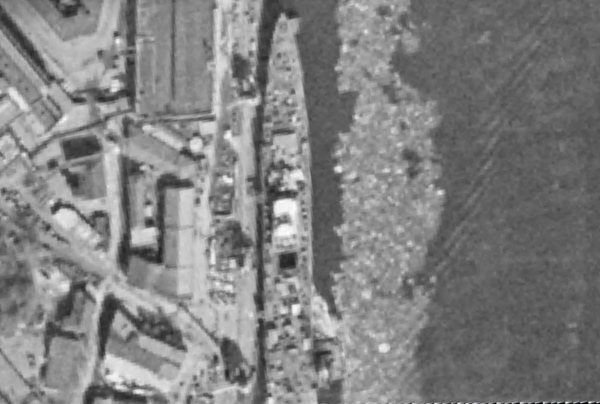 The new combatant was launched in 1977 and by April 1978 was moored in the Neva River, still containing winter ice. The ship's deck is covered with construction equipment. The bridge and central superstructure are visible. |
In April 1978, HEXAGON mission 1214 photographed Leningrad. By now the ship was moored in the Neva River, its hull surrounded by the last of the winter ice. Although the image resolution was not great, it was clear that the ship was still only partially complete, with equipment strewn across its deck. Only in the next year would the remaining construction equipment be removed, revealing the ship’s unique topside, with most of its weapons concealed by hatches, and the wide array of antennas on its superstructure. The ship was over twice the displacement of the largest US Navy nuclear-powered cruiser.
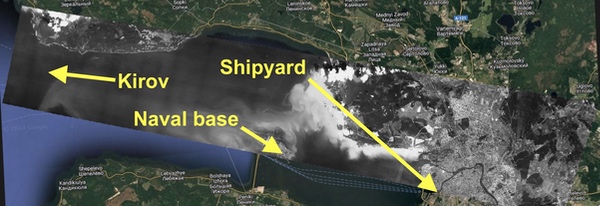 In July 1980, a HEXAGON satellite photographed Leningrad and the entrance to the Gulf of Finland. Each HEXAGON photograph covered a huge amount of territory and could be enlarged to reveal details to a resolution of about 0.3 meters at best. This single image captured the Kirov in the bay, the naval base, and the shipyard, where a second Kirov was already under construction. That ship would be named Frunze. (larger version) |
The Frunze takes shape
After focusing on the Kirov, over the next several years American satellites continued to photograph the shipyard at Leningrad and by the latter half of 1978 they revealed the construction of a second ship similar to Kirov. In July 1980, HEXAGON mission 1216 photographed a large ship with the same hull dimensions as Kirov under assembly. But the HEXAGON’s ability to photograph large amounts of territory in a single image meant that not only did it photograph the new ship—eventually named Frunze—but also the Kirov, moored in the Bay of Finland. The Soviet battlecruiser was surrounded by a fleet of small security ships, indicating that he (Soviet warships were referred to as “he” in Russian) was now undergoing sea trials. In October, the Kirov was spotted by NATO patrol planes north of the Norwegian coast. They photographed it as well, and photos of the large warship were finally publicly released.[3]
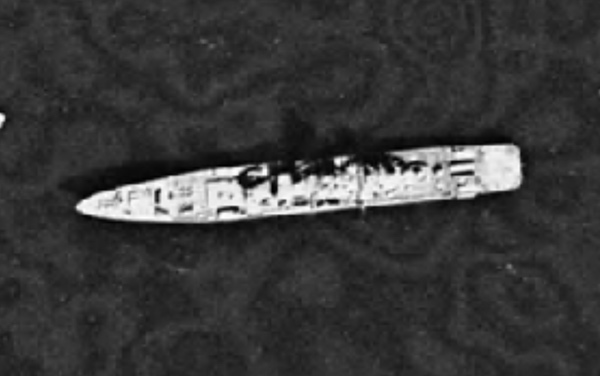 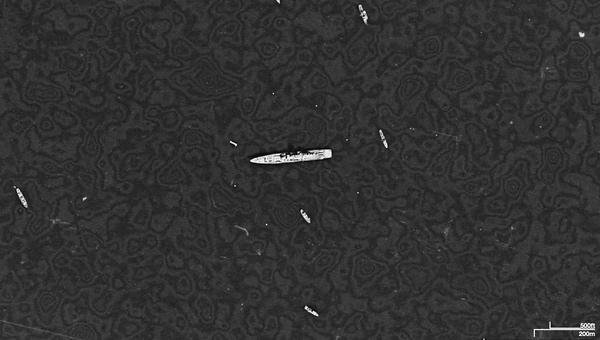 The Kirov was undergoing sea trials in summer 1980, but did not sail beyond Soviet waters until October. It conducted live fire weapons tests late in the year. Here it is moored in July 1980, surrounded by many small support and security vessels. |
A December 1980 report by the CIA’s National Foreign Intelligence Center on the status of Soviet shipbuilding stated that the Kirov had conducted sea trials earlier in the year and by late 1980 was beginning weapons tests. It also stated that the CIA believed that the second ship, still under construction, would be launched in 1981 and would be the last of this type built by the Soviet Union. The report declared that “the information and judgments presented in this publication were derived principally from analysis of imagery.”[4]
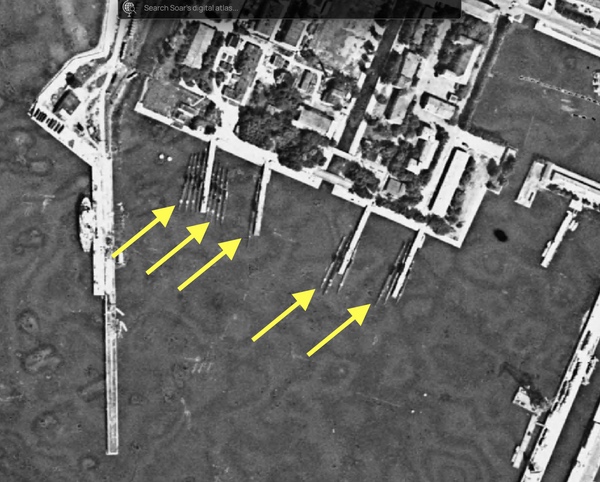 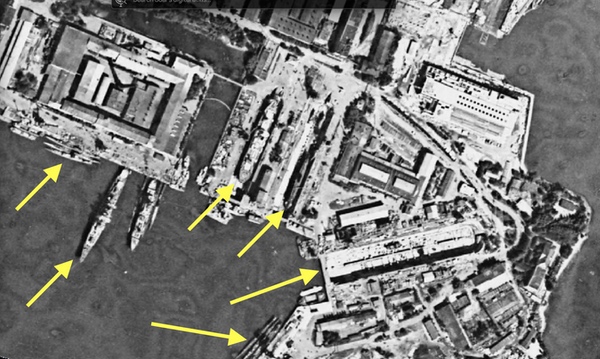 The Soviet naval base at Leningrad supported numerous conventionally powered submarines as well as surface ships. It also had multiple dry-docks for servicing the ships. Here it was photographed by a HEXAGON satellite in July 1980. |
The report provided some indications of how the photo-interpreters assessed Soviet shipbuilding. They measured the length and beams of ships under construction, but also studied the arrangement of major structural bulkheads and machinery space openings. This undoubtedly required the higher-resolution GAMBIT satellites because the HEXAGON, and even the KENNEN, could not provide as much detail as the exquisite photographs produced by GAMBIT. In addition, analysts also kept track of how long it took to assemble a ship, as well as how much time passed between the launching of a ship and the start of construction of the next ship in the yard. An extended delay in the start of new construction could indicate that a new class of ship was being built.
 While the Kirov was beginning sea trials in July 1980, the second ship in the class, eventually named Frunze, was under construction at the Leningrad shipyard. The ships had a helicopter hangar and variable depth sonar at the stern. |
The construction of the Kirov and its follow-ons played a major role in the United States Navy bringing its Iowa-class battleships back into service during the Reagan defense buildup of the 1980s. The Reagan administration proposed reactivating the battleships within a month of entering office. In April 1981, Naval Reserve Captain David J. Kenney, who was described as “a specialist in Soviet naval operations,” wrote an op-ed for the New York Times where he described the Kirov as “a brilliantly realized combat design. Exotic missiles, helicopters, heavy conventional guns, and extensive antisubmarine armaments complete the most dazzling array of naval gadgetry ever brought to sea in one hull.” He also predicted that “by the mid-1980s, the Soviet Navy will undoubtedly operate nuclear carriers,” which it never did.[5]
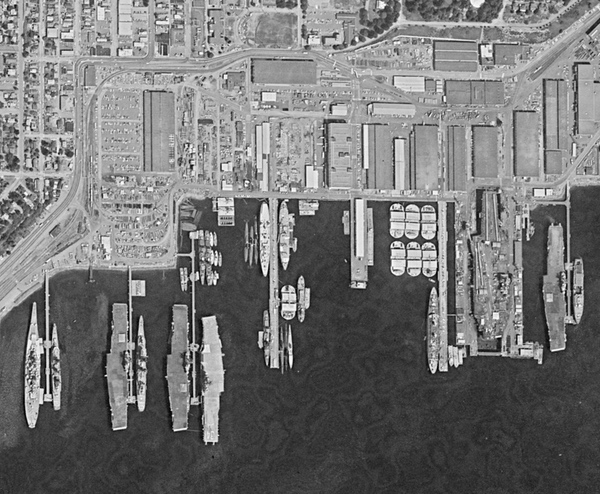 Puget Sound Naval Shipyard at Bremerton, Washington, in June 1982 was undertaking an overhaul of one of the US Navy’s large aircraft carriers. Four retired World War II-era Essex-class carriers, including USS Hornet, were stored there, as was the battleship USS Missouri, seen at left. Missouri and her three sister ships would soon be brought back into service, equipped with cruise missiles. This was in part the Reagan administration's response to the Soviet Kirovs. |
The Ural
In March 1983, American photo-interpreters reported that a “probable major combatant was under construction” at the shipyard again, and stated that it had “an incomplete length of 169 meters and a beam of 30 meters.” They previously suspected that this was a logistics support ship, but by March had concluded that “the compartmentation of this ship is more indicative of a combatant.” The amidships section of the ship had been completed up to the main deck level and there was a possible helicopter deck and elevator aft, just like with Kirov.[6]
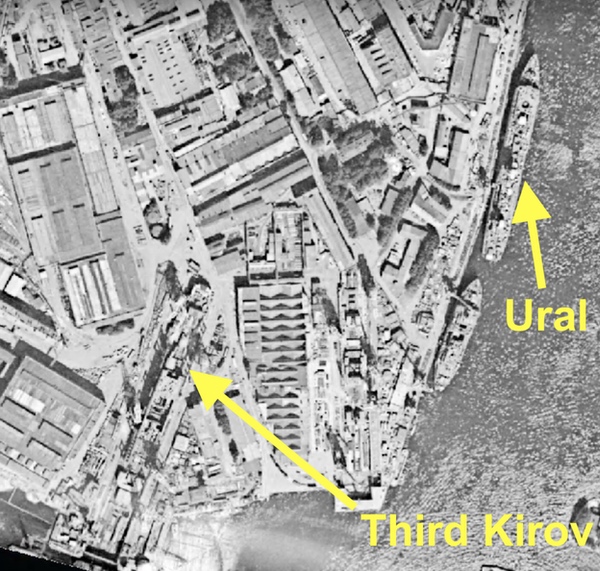 During 1981-1983, a surface combatant with a beam two meters wider than the Kirov was under construction at Leningrad. This ship was launched in 1983 and was identified as a nuclear-powered communications and space tracking ship, eventually named Ural. It was moored in the river so its large antennas could be installed. A third Kirov was under construction by July 1984, when a HEXAGON satellite took this photo. |
But the photo-interpreters noted that “although numerous similarities exist between this ship and the two Kirov CGN [nuclear-powered guided missile cruisers], this unit cannot be identified as a Kirov CGN. The distinctive Kirov bottom plate was not observed during early construction stages, and the beam of this ship is two meters wider than the maximum beam of the Kirov CGN.”
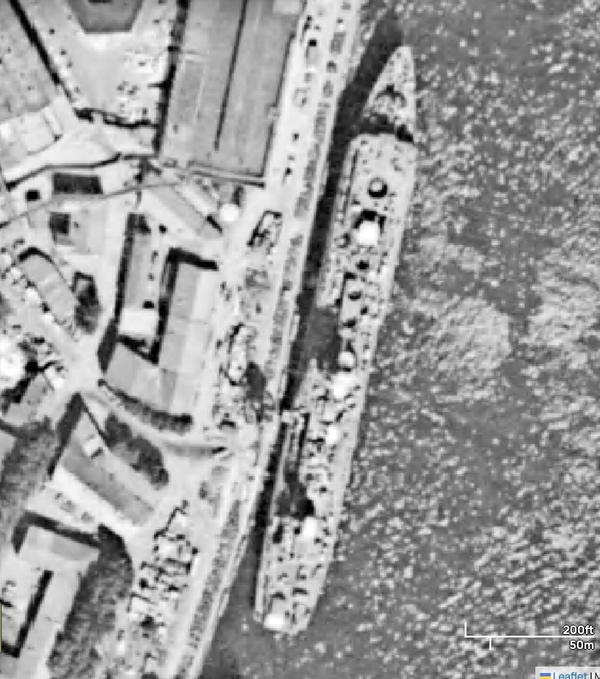 The Ural communications ship in the Neva River in July 1984. Final construction on this ship dragged on for years, and it never entered service in its intended role. The Soviet Union spent considerable resources on what proved to be a useless vessel. |
The declassified 1983 cable on this new ship demonstrates just how good American satellite intelligence collection and interpretation was by this time. The ship’s dimensions were accurately measured while under construction—it was indeed two meters wider than the Kirov—and it was not a logistics ship. Instead, as construction continued, American reconnaissance satellites photographed it and revealed that it supported several large antennas, much bigger than carried by previous combatants. It was assessed to be a nuclear-powered communications and satellite tracking ship. Limited declassified records do not indicate when and how American analysts determined that the vessel was nuclear-powered. But other declassified records about Soviet submarine construction state that American satellites spotted components for nuclear reactor containment vessels at an assembly yard, and presumably there were also similar indications at the Leningrad yard.
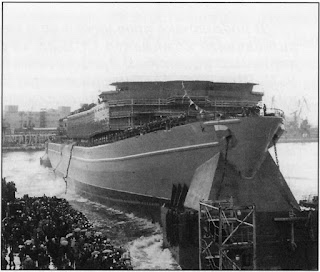 A rare ground-level image of the launching of the Ural in 1983. Few good photos of the Kirovs or Ural under construction have been released. This photo shows how the ships slid into the river. They were then moored nearby for fitting out. |
Kalinin
In July 1984, the last successful HEXAGON mission, number 1219, photographed the shipyard again, revealing another large combatant under construction. This one was nearly identical to the first two Kirov battlecruisers, indicating that the Soviet Union was continuing to build these large warships. That ship was eventually launched in 1988 and named Kalinin. Also moored nearby was the large communications ship that had previously been built in the shipyard. It was still undergoing construction. It was named Ural.
No more recent reconnaissance satellite photos of the Kirovs under construction have been declassified. To date, no GAMBIT images, which would show the ships in much greater detail, have been released. They would provide indications of just how much the US intelligence community knew about the interiors of the ships. KENNEN undoubtedly also photographed the Soviet shipyards, but KENNEN’s main strength was its timeliness, not its resolution.
Eventually a fourth and final Kirov was launched. All four of the ships were renamed after the collapse of the Soviet Union and the first two were scrapped. Kalinin, renamed Admiral Nakhimov, is undergoing a lengthy refurbishment and is expected to eventually replace the only operational ship, Peter Velikiy, which will probably be scrapped due to its high operating costs. As the United States continues to declassify information from the last decade of the Cold War, it will be possible to piece together what the US intelligence community knew about the dawn of the age of these massive and powerful ships.
References
- Bernard Weinraub, “Soviet Said to Launch First Nuclear Surface Warship,” The New York Times, February 8, 1978, p. A7.
- Richard Halloran, “Soviet Navy Building Its First Nuclear-Powered Carrier Other Developments Cited,” The New York Times, December 17, 1979, p. A9.
- “Soviet Nuclear Cruiser Sails to Join Northern Fleet,” The New York Times, October 2, 1980, p. A7.
- “Status of Soviet Construction Programs for Major Surface Combatants, December 1980,” National Foreign Intelligence Center, Central Intelligence Agency, February 1981. CREST CIA-RDP81T00380R000100500001-7
- David J. Kenney, “The Soviet Naval Threat,” The New York Times, April 5, 1981, Section 4, p. 21.
- “Probable Combatant Under Construction, Leningrad Shipyard Baltic Ordzhonikid 189, USSR,” National Photographic Interpretation Center, Priority Exploitation Group (NPIC/PEG), March, 1981. CREST CIA-RDP89-00121R000200500004-2
Note: we are now moderating comments. There will be a delay in posting comments and no guarantee that all submitted comments will be posted.
